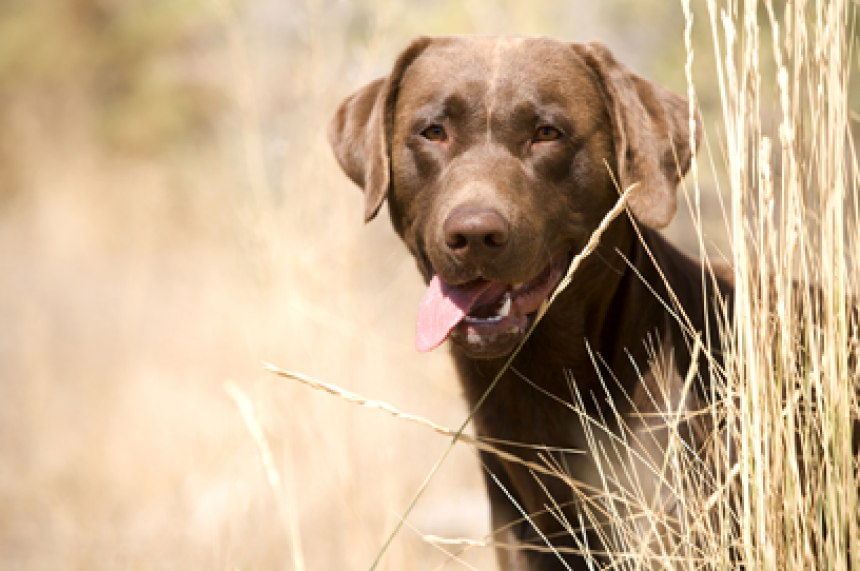Why is genetic testing important?
Genetic information obtained from DNA works as a “blueprint” dictating physical and biological characteristics. As half of the information comes from each parent, inherited conditions can be passed on to offspring. The Michigan State University Veterinary Diagnostic Laboratory (MSU VDL) offers a series of diagnostic genetic tests for the purpose of detecting disease-associated genetic alterations and identifying an animal’s risk of developing inherited conditions. Moreover, it can help determine a breeding plan leading to the reduction and eventual elimination of inherited conditions in a particular breed. A small blood sample (1 ml) is all that is needed, and the results are ready in two weeks on average.

When should one consider submitting genetic testing?
Genetic testing for inherited conditions should be strongly considered when:
- The animal has a clinical presentation or family history that suggests an inherited condition
- A parent of the animal is a carrier for an inherited condition
- There is a presence of birth defects, such as neurologic or skeletal abnormalities, that are known to be associated with inherited disease
- Purebred or mixed breed animals are known to have an increased chance of having a certain hereditary condition
How does it work?
Genetic testing is performed in different ways, including:
- Diagnostic testing is performed in order to identify or rule out the symptom causing mutation and, in many cases, to confirm the diagnosis.
- Predictive testing is used when there is a probability of carrying the mutation and developing symptoms later in life yet no symptoms are detected.
- Carrier testing is relevant for animals that may carry a mutation (but are not themselves affected) as there is risk for their offspring to be affected.
- Pharmacogenomic testing gives information about how certain medicines are processed by an animal’s body. This type of testing can help veterinarians choose the medicines that work best with the animal’s genetic makeup.

Conditions
This genetic testing assesses an animal’s mutation status for inherited conditions, including:
- Conditions that shorten lifespan or affect quality of life
- Conditions where early treatment can make a difference
- Conditions where specific treatments/managements are required
- Conditions where there are limited or no treatment options available
A full list of inherited conditions/mutations that are currently available at the MSU VDL is included here.
-
Conditions
Species
Affected breeds
Clinical signs
-
Centronuclear MyopathyCanineLabrador RetrieversWeight loss, a loss of muscle tone and control, an awkward gait, and extreme exercise intolerance
-
Degenerative MyelopathyCanineBernese Mountain Dog and multiple breedsProgressive weakness and incoordination of limbs
-
Dystrophic Epidermolysis BullosaCanineGolden RetrieverFragile skin that is easily damaged from rubbing or trauma resulting in blisters and ulcers of the oral and esophageal mucosal, scarring of the skin, nails dystrophy, and growth retardation
-
Exercise-induced CollapseCanineLabrador RetrieversWobbly gait after exercise, which soon progresses to nonpainful, flaccid paraparesis and a loss of control of the rear limbs
-
F7 deficiencyCanineAiredale Terrier, Beagle, Deerhound, Finnish Hound, Giant Schnauzer, Welsh Springer Spaniel, and Alaskan Klee KaiMild bleeding disorder
-
Hereditary CataractsCanineAustralian ShepherdBilateral progressive posterior cataract
-
HyperuricosuriaCanineMultiple breedsUrate urolithiasis, Urinary tract obstruction
-
IchthyosisCanineLabrador Retriever, Flat-Coated Retriever, Curly Coated Retriever, and Chesapeake Bay RetrieverExcessive production of dandruff, thickened and hyperpigmented skin, generalized scaling
-
Junctional Epidermolysis BullosaCanineGerman PointerFragile skin and blistering disorder of the skin and mucous membranes
-
Late Onset AtaxiaCanineParson Russell Terrier and Jack Russell TerrierIncoordination of gait and lack of balance
-
Multidrug SensitivityCanineMultiple breedsAccumulation and toxicity of some drugs
-
Neonatal Encephalopathy with SeizuresCaninePoodleSevere generalized clonic-tonic seizures
-
Neuronal Ceroid LipofuscinosisCanineGolden RetrieverProgressive neurodegeneration resulting in progressive motor decline with seizures and loss of coordinated muscle movements, cognitive decline and abnormal behavior, and early death
-
ObesityCanineLabrador Retriever, Flat-Coated RetrieverObesity
-
Persistent Mullerian Duct SyndromeCanineMiniature SchnauzerDevelopmental abnormalities of the male reproductive tract
-
Pituitary DwarfismCanineGerman Shepherd, White Shepherd, Karelian Bear Dog, Saarloos Wolfdog and the Czechoslovakian WolfdogGrowth retardation and poor body condition due to inadequate production of the Growth Hormone
-
Primary Lens LuxationCanineMultiple breedsDislocation or displacement of the lens in the eye due to weakened zonular fibers
-
Progressive Retinal AtrophyCanineGolden Retrievers and GoldendoodlesProgressive vision loss leading to total blindness due to bilateral degeneration of the retina.
-
Progressive Retinal AtrophyCanineMultiple breedsNight blindness and loss of peripheral vision leading to total blindness due to degeneration of both rod and cone photoreceptor cells of the retina
-
PTPN11 MutationCanineBernese Mountain Dog and multiple breedsHistiocytic sarcoma
-
Renal Cystadenocarcinoma and Nodular DermatofibrosisCanineGerman ShepherdBilateral multifocal tumors in the kidneys, uterine leiomyomas and dermatofibrosis in the skin
-
Skeletal DysplasiaCanineLabrador RetrieversShort legs with normal length and width of the body
-
Spinocerebellar AtaxiaCanineJack Russell Terrier, Smooth-haired Fox Terrier and Toy Fox TerrierProminent hypermetria along with a bouncing gait and falling with difficulty returning to standing position
-
Von Willebrand’s Disease Type 1CanineMultiple breedsExcessive bleeding
-
Von Willebrand’s Disease Type 2CanineChinese Crested, Collie, Deutsch Drahthaar, German Longhaired Pointer, German Shorthaired Point, German Wirehaired Pointer, and PointerBleeding disorder
-
Von Willebrand’s Disease Type 3CanineScottish Terriers, Dutch KooikerSevere bleeding disorder
-
Hypertrophic CardiomyopathyFelineMaine Coon, RagdollCardiac disease, heart failure
-
Polycystic Kidney DiseaseFelineMultiple breedsRenal failure, multiple cysts forming in the kidneys as well as hepatic and pancreatic cysts
-
Pyruvate Kinase DeficiencyFelineMultiple breedsHemolytic anemia
-
Spinal Muscular AtrophyFelineMaine CoonAbnormal gaits due to muscle weakness
What happens next?
Results from genetic testing can predict with a high level of confidence that an animal will fall into one of three categories:
An “Affected” test result means that the animal has a specific genetic alteration (or mutation) that is associated with a hereditary disease. If the animal has a clinical abnormality, it confirms the diagnosis of a hereditary condition. If the animal is clinically normal, an affected result may indicate an increased risk of developing certain conditions in the future. However, it does not guarantee the animal will get the disease. It does mean the mutation will be passed on to offspring.
A “Carrier” test result means that the animal has both a normal and mutated copy of the gene (autosomal recessive diseases). Active disease is unlikely to occur. This mutation can, however, be passed to offspring. If both parents have a mutation, there is a 1 in 4 (25%) chance for every pregnancy that the offspring will inherit the mutation from both parents and develop disease. A “Clear” test result means that the animal does not have the gene change. This may mean the disease does not run in their family or was not passed on to them.
A “Clear” result means that the animal is extremely unlikely to develop the genetic condition. The risk of developing the disease is the same as it is for other animals.
Why MSU VDL?
Our genetic testing has been designed to be highly accurate and comprehensive. We are dedicated to helping veterinarians and pet owners make informed decisions about their animal’s health.
Later this year, individual tests will be bundled into breedspecific panels to make it easier to order genetic screening for a particular breed.
